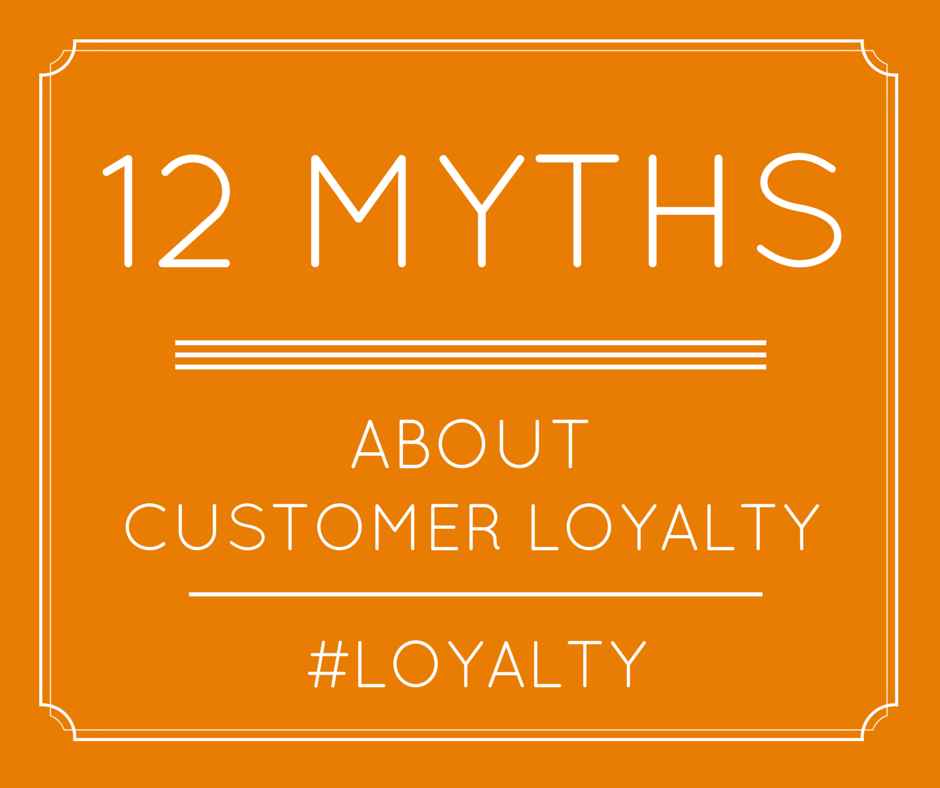Customer loyalty: the ability to acquire and retain repeat customers. Whether you manage a small local diner or a large global corporation, customer loyalty is important to you and it should not be overlooked. Today we are going to put to rest 12 customer loyalty myths in order to help your business better promote customer and brand loyalty.
1. People just aren’t loyal to brands anymore
This is not at all true! How many people out there will only drink Coca Cola or Pepsi? Will only wear Nike or Adidas runners? Will only stay at The Marriott or The Best Western? Will only shop at Woolworths or Coles? Will only purchase Apple technology? The list goes on and on.
2. A satisfied customer = A loyal customer
Let’s get technical. Customer satisfaction is a measurement of the attitudes towards services, products, and brands. Customer loyalty is a combination of behaviors, repeat purchases, attitudes, opinions and feelings relating to these repeat purchases. Customers can display loyalty behavior without having loyalty attitudes. Equally, customers can display loyalty attitudes without showing loyalty behaviors.
Example 1. Continuing to use a telephone provider regardless of your negative feelings/opinions towards their service.
Example 2. You love flying Qantas Airways and they are your preferred airline, but you wouldn’t be opposed to flying with other international airlines if there was a perceived higher value of doing so.
3. Our customers just want the lowest price
As shown in Nielsen’s Global Loyalty Report 2013, consumers are more attracted to products with “better quality” (29%) over those with “better price” (28%). The margin may be small, but need we say more?
4. Customers will automatically stay with you if they like your company
Humans are fickle beings. Yes, they may like your company, but don’t underestimate what proactive steps your competitors are taking to try and attract more customers, possibly your customers. Never, ever take your customers for granted and assume that they’ll just stick around. Be proactive and one step ahead of your competitors.
5. Personal interaction = customer loyalty
In the highly digital world that we live in today, we cannot solely rely on personal interaction with customers to increase loyalty. You must have an online and offline presence. An example of an online presence would be tapping into the relationship customers have with their smartphones. For instance, creating a digital loyalty program that allows customers to access their loyalty cards and check their points balances straight from their phone.
6. Technology alone will increase customer loyalty
Like with personal interaction, only investing in technology to increase customer loyalty will not always yield the best results. For some businesses, keeping most of the interaction online will be relevant and accepted by customers. Your company needs to find its own optimal balance between online and offline communications depending on customer expectations and needs.
7. Frequency of contact increase customer loyalty
Who enjoys heaps of spammy emails? No one! Increased contact with your customers won’t always have a positive impact. Make sure you are using the right communication mediums and define how regularly you want to contact your customers, without being annoying!
8. Building loyalty is too expensive for small brands
There are many affordable solutions out there for small brands to build a loyal customer base. Check out Loopy Loyalty to see how simple and cost effective running a digital loyalty campaign can be.
9. Retention improvements don’t make a big impact on the bottom line
A survey conducted by Marketing Metrics, stated that the successful sale to an existing customer is 60%-70%, whereas that of selling to a first-time customer is 5%-20%. There is an enormous potential for cross-selling and upselling, therefore increasing your company’s bottom line.
10. Customer retention is nothing more than a necessary cost with no real ROI
It is tricky to calculate ROI for customer loyalty. But not impossible! Instead of focusing on ROI specifically, look at the Customer Lifetime Value (CLV) instead. This is the projected revenue that a customer will generate during their lifetime. This method uses easily accessible variables and provides a dollar figure on completion. Learn how to do it here.
11. Customer satisfaction surveys are your only research for loyalty
Surveys are a great way to gain qualitative insight into your customers’ level of satisfaction. However there are quantitative metrics that can be used to measure customer loyalty. With online tools and analytics you can track how many loyal customers you have, how often they are purchasing, how much revenue individuals are bringing in and much more.
12. Customer loyalty is impossible to track
You can easily track customer loyalty with membership cards, unique customer numbers, and loyalty and rewards cards. Is your membership base growing? Are members spending more this month? Are members cancelling their memberships? All of these are metrics that you should be tracking to gauge customer loyalty.
What brands are you loyal too? What have these companies done to acquire your loyalty? Is there anyone out there 100% loyal to one particular brand? Please share your responses in the comments below!















